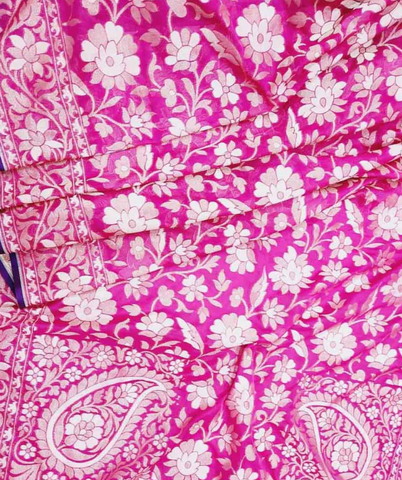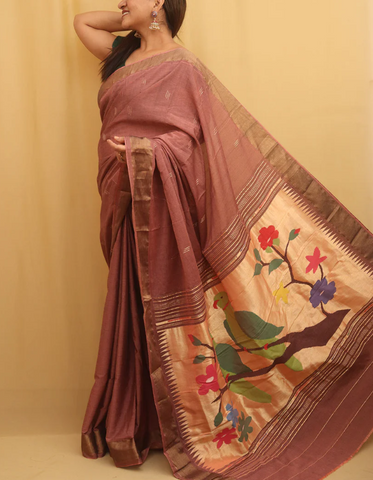Sarees have been a quintessential part of the Indian subcontinent's culture and fashion legacy, with cotton sarees, in particular, embodying a sense of grace, comfort, and tradition. When considering a cotton saree for women, it's crucial to contemplate its fabric, weave, and design to ensure it aligns with your style and comfort needs. The vast array of cotton sarees available can be overwhelming to explore, but each piece has its own story to tell and a unique charm to offer. Whether you're a saree enthusiast or simply looking to build your Indian wardrobe, this guide will walk you through the essential steps to pick the perfect cotton saree for any occasion.

Understanding Cotton Fabrics
Before you begin your saree quest, it’s important to understand the foundational fabric of cotton. Cotton is a versatile textile that offers a myriad of options when it comes to sarees. From the earthiness of handloom cotton to the sheen of chanderi, each fabric has its own set of characteristics.
Types of Cotton Fabrics
- Handloom Cotton: Handloom sarees are known for their unique textures and traditional roots. They are woven on a hand-operated loom, often by skilled artisans who maintain age-old weaving techniques.
- Khadi Cotton: Popularized by Mahatma Gandhi, khadi cotton is a hand-spun and hand-woven fabric that is symbolic of simplicity and self-reliance. Sarees made from khadi are lightweight and have a slightly coarse texture.
- Chanderi: Chanderi sarees come in both cotton and silk-cotton variants. They are known for their sheer texture, lightweight feel, and fine zari work that adorns the borders and pallu.
- Mulmul: Mulmul, also known as muslin, is a soft and lightweight cotton fabric with a delicate weave. It is often used to create sarees that are breezy and perfect for warmer climates.
How to Choose the Right Fabric
When choosing the fabric of your saree, consider the occasion and the climate. Handloom sarees are ideal for formal events and are more substantial in weight and texture. Khadi cotton is a great choice for casual wear and the warmer months. Chanderi, with its mix of silk and cotton, is a versatile option that can transition from day to night. For those who prefer a balance between traditional and modern aesthetics, a cotton silk saree serves as an impeccable choice, blending the comfort of cotton with the luxurious sheen of silk.
Determining Your Style Preferences
Personal style plays a significant role in choosing a cotton saree. It's not just about following trends but about feeling confident and comfortable in what you wear.
Occasion
The event you’re dressing for should guide your style. Intricately patterned handloom sarees are perfect for weddings or festivals, while simpler cotton sarees can be your go-to for everyday wear. If you're attending a formal event, opt for a chanderi or cotton silk saree for an elegant touch.
Body Type
Different saree styles flatter different body shapes. If you’re petite, opt for narrower borders and smaller motifs. Broader borders and bolder designs can add dimension for those with a taller frame. For a curvier body, choose sarees with lighter fabrics and avoid heavy embellishments.
Colors and Patterns
Select colors and patterns that resonate with your personality and complement your skin tone. Vibrant hues like red, blue, and green are a popular choice, but pastels also have their classic charm, especially in summer. For a look that is both elegant and serene, a white cotton saree can be a perfect choice, embodying purity and simplicity while providing a canvas for bold accessories.

Color Coordination and Skin Tone
Choosing the right color is just as important as selecting the fabric or design. Colors can significantly impact the overall look and feel of a saree, enhancing your natural beauty when chosen correctly.
Matching Saree Color with Skin Tone
- Fair Skin: Lighter shades like pastels, beige, or light pink can beautifully complement fair skin, highlighting its natural glow. However, to add a bit of contrast, vibrant colors such as deep reds or greens can also be striking.
- Medium Skin: Earthy tones like olive, mustard, and rust work wonders for medium skin tones, adding warmth and richness to the overall look. Blues and maroons are also flattering options.
- Dark Skin: Bold and deep colors like burgundy, navy blue, and dark green accentuate darker skin tones, making them appear radiant. Bright colors should not be shied away from, as they can add a lively contrast.
Considering the Time of Day
The time of the event can also influence your saree color choice. Light and breezy colors are ideal for day events, making you look fresh and vibrant under the sun. For evening occasions, darker shades or sarees with a metallic sheen (like those with zari work) can add an air of sophistication and glamor.
By taking into account these considerations of fabric, style, and color, you're better equipped to find a cotton saree that not only matches your personal aesthetic but also elevates your look for any occasion. Remember, the perfect saree is one that you feel most comfortable and confident in.

Assessing Quality
A quality cotton saree will not only last longer but will also feel and drape better. Here’s how to spot the finest choices.
Thread Count
A higher thread count generally indicates a finer fabric. For cotton sarees, a 200-400 thread count is considered good quality.
Weaving Technique
The weaving technique used on the fabric can significantly impact its quality. Look for even weaving with no skipped threads or gaps.
Finished Edges
The pallu, borders, and hemline should all have neatly finished edges. This is a sign of superior craftsmanship and attention to detail.
Authenticity
If you’re eyeing a handloom cotton saree, inspect it for traditional motifs specific to the region it's from. Counterfeit sarees often have generic designs.
Exploring Embellishments and Work
Cotton sarees can be as elaborate or as understated as you want them to be. Here are the elements that can enhance the beauty of the fabric.
Embroidery
Intricate thread work or ‘zari’ embroidery can add a touch of opulence to a cotton saree, making it suitable for festive or ceremonial wear.
Prints
Block prints, hand paintings, and screen prints are popular choices for cotton sarees. They range from simple geometric patterns to complex designs inspired by nature or cultural motifs.
Zari Work
A subtle use of zari in the borders or pallu can elevate the saree, making it a statement piece without compromising the comfort of the cotton fabric.
Budgeting and Pricing
The price of cotton sarees can vary greatly depending on the fabric, craftsmanship, and the brand.
Factors Affecting Price
Genuine handloom sarees and those with intricate designs are usually priced higher due to the craftsmanship involved. Machine-made cotton sarees, while more affordable, may lack the same level of detail and quality.
Setting a Budget
Prioritize what matters most to you. If you're looking for a long-term investment piece, be prepared to allocate a larger budget. On the other hand, if you're updating your wardrobe with seasonal choices, you might opt for more budget-friendly options.
Timeless Pieces vs. Budget-Friendly Options
Timeless pieces are always a good investment but don't shy away from exploring more affordable options for everyday wear. With the right care, even budget-friendly sarees can last a long time.
Shopping Tips and Resources
When it comes time to shop, there are several strategies to help you find the perfect cotton saree and ensure its authenticity.
Retailers
For those seeking convenience without compromising on quality, shopping for pure cotton sarees online from trusted platforms like Luxurion World can offer a vast selection of authentic, high-quality options.
Negotiating and Discounts
Many small boutiques and local artisans are open to negotiation, especially if you’re buying in bulk or are a return customer. Keep an eye out for seasonal sales and promotions to score the best deals.
Recommendations
Don't be shy about seeking recommendations. Friends, family, and online forums can offer valuable insights and direct you to trusted sellers.
Your Perfect Saree Awaits
Cotton sarees are not just garments; they are stories spun out of threads, reflecting the vibrant culture and history of India. Each fold and drape is a canvas, ready for you to make your mark. By considering the factors above, you will not only select a cotton saree that looks beautiful but one that feels like an extension of yourself. Happy saree shopping, and may you find the perfect weave for your dreams and desires!
Frequently Asked Questions (FAQs)
What are the different types of cotton sarees available in the market?
The market has a variety of cotton sarees, each with unique charm and qualities. Key types are: Bengal Cotton - lightweight and breathable, Khadi Cotton - handspun texture and historical significance, Sambalpuri Cotton - traditional motifs and craftsmanship, and Chettinad Cotton - bold colors and striking designs.
How can I determine the quality of cotton used in a saree?
To assess cotton quality in a saree, focus on thread count - a higher count indicates a finer weave. Genuine cotton feels soft on the skin. Check weave for consistency, no gaps.
What are the factors to consider while choosing a cotton saree based on the occasion?
When choosing a cotton saree, consider the occasion's formality and your comfort. For casual wear, go for light-printed sarees. Festivals and weddings require vibrant colors and intricate patterns. Opt for solid colors or subtle prints for formal events.
How do I select the right color and design of a cotton saree that suits my complexion and body type?
Choosing the right color and design of a cotton saree involves considering your complexion and body type. Fair skin tones may prefer pastels and bright colors, while deeper skin tones can carry off vibrant shades. Vertical stripes or lighter prints elongate the body, suitable for various body types. Large prints work for taller individuals, and darker shades or slimmer prints flatter curvier body types. Choose a saree that reflects your style and boosts confidence.

